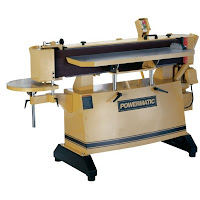Over the years, I’ve told many people that, next to the table saw, my edge sander has been the most utilized of all the woodworking tools in my shop. That may be because my woodworking designs always seem to have a lot of curved surfaces incorporated into them. While it is true that an edge sander can sand long, straight edges, I use it to sand inside and outside curves far more often than straight edges.
With an edge sander, I can even sand large, round table tops using a jig with a pivot pin in the center. (See my woodworking article on that subject at PerfectWoodworking.com/edgesanderjigarticle.) My machine uses 6” x 108” sanding belts and has about a three-foot platen surface. Outside curves are sanded on the front table and inside curves on the end table using the curvature of the idler drum. My edge sander does not oscillate and neither the front table nor the platen can be tilted. Most machines being sold today are less limited than that.
My technique is to mark the final profile to be sanded with a pencil line on the workpiece and then cut just outside of that line by about one blade width with the band saw or a jig saw. If the work piece is too large to manage on the band saw, I use the jig saw (sabre saw) to make the cut. After that, I use the edge sander to bring the work piece down to its final dimensions.
An oscillating edge sander keeps the sanding belts from loading up and burning by constantly moving the sanding belt up and down with reference to the work piece. An edge sander with a tilting front table or a tilting sanding head allows you to sand bevels and even compound angles.
If you’ve used edge sanders much, you know that, at a certain point, the sanding belt is going to go, announcing its departure from this world with some scary rumblings followed by a loud bang. I have never been hurt by this but I have always jumped away from the machine at the first sign of trouble.
One good way to keep this from happening is to make sure that your sanding belts are no more than 6 months old because the glue that holds the lap or butt joint together tends to dry out and weaken with time. When ordering sanding belts, keep this in mind. Ordering sanding belts in large quantities may not a bargain in the end if you are ordering more sanding belts than you can use up in 6 months. Butt jointed sanding belts will leave a smoother finish but lap joints are much stronger and less likely to come apart.
Another explosion-avoidance technique is to, whenever possible, avoid sanding sharp, pointed edges that can tear into the sanding belt and rip it up. If your machine has a coating on the platen, such as graphite, that will help reduce the friction between the back of the belt and the platen which will reduce heat buildup that shortens the life of your sanding belts.
Dust collection on any edge sander is an absolute must and the dust collector must be large enough to handle any amount of sanding dust that might be created by your edge sander. If you don’t already own a dust collector that can suck up at least 600 cubic feet of air per minute (or more) you will have to add the cost of that machine onto the cost of the edge sander. So, when considering the cost of an edge sander, make sure you are looking at the total cost, not just the cost of the edge sander itself.
To assist you in selecting the best edge sander for your personal or business use, take a look at our review of four machines from Delta, Jet and Powermatic at PerfectWoodworking.com/edgesanderreviews2/.
We examine several types of machines in a wide price range.
Bob Gillespie
Woodworker
© 2010
For similar articles and tool reviews, see:
PerfectWoodworking.com
Monday, January 11, 2010
Subscribe to:
Post Comments (Atom)



2 days ago, I told about about Jim's WoodProfit course.
ReplyDelete==> http://www.woodprofits.com?kslskd547fd
I've spoken on the phone with Jim Morgan and I'm just
blown away by his simple and effective strategy to
make money using his basic woodworking skills.
He started his woodworking business with NO capital,
a few shop tools, and a lot of nerve, in a small
10x20 foot space and grew it into a 1,400 space in
the first few months while still remaining as a
one-person business!
See his story at:
==> http://www.woodprofits.com?kslskd547fd
Now if you want earn some pocket money during this
recession and run an easy to start and fun business,
then you'll LOVE this guide.
It contains all the information you need to start making
money from the very first job...
==> http://www.woodprofits.com?kslskd547fd
Excellent article. Very interesting to read. I really love to read such a nice article. Thanks! keep rocking. cutthewood.com
ReplyDelete